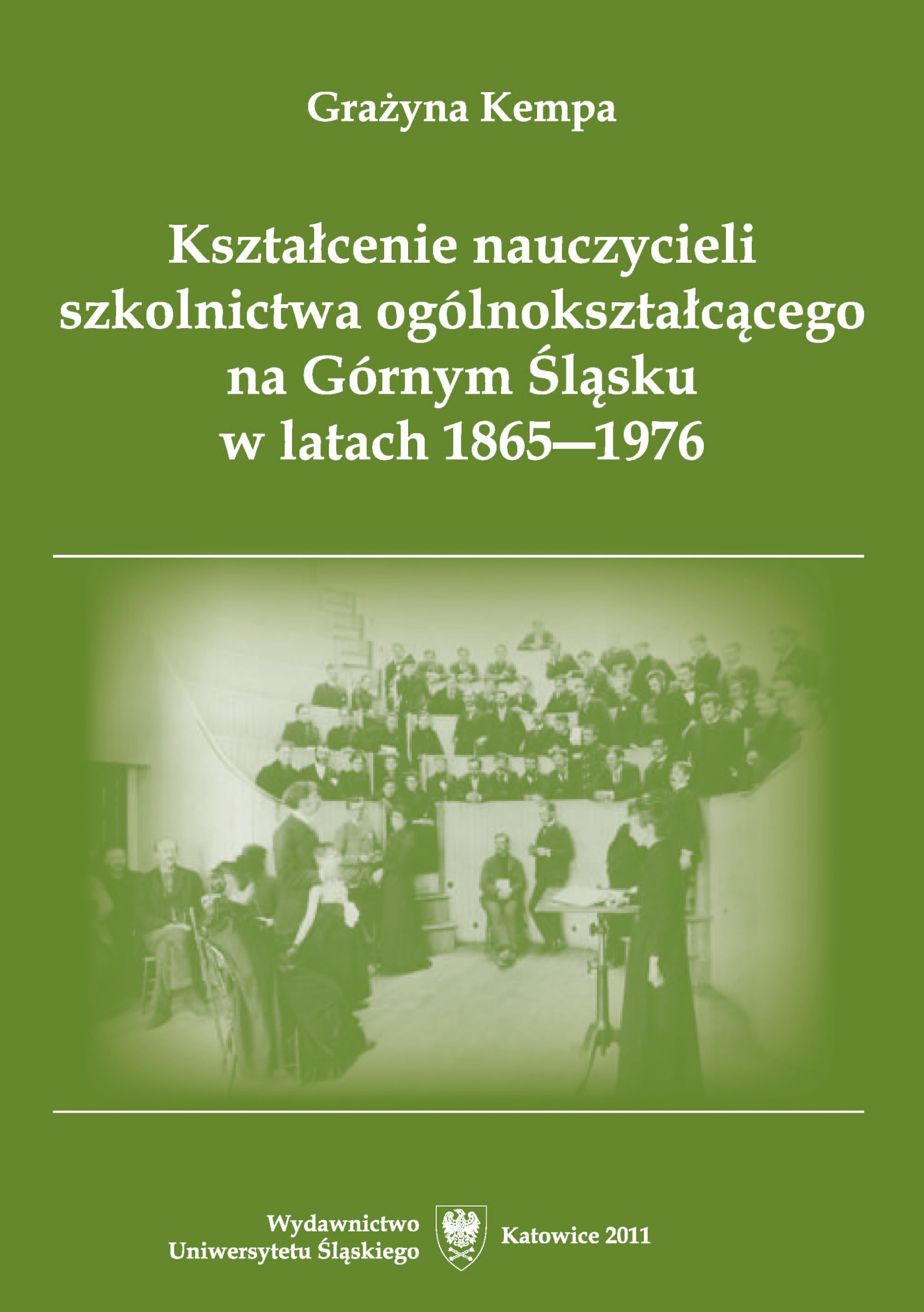Kształcenie nauczycieli szkolnictwa ogólnokształcącego na Górnym Śląsku w latach 1865–1976
Educating secondary school teachers in Upper Silesia between 1865—1976
Author(s): Grażyna Kempa
Subject(s): Cultural history, Social history, 19th Century, Interwar Period (1920 - 1939), Post-War period (1950 - 1989), Pedagogy
Published by: Wydawnictwo Uniwersytetu Śląskiego
Keywords: secondary school teachers; Upper Silesia
Summary/Abstract: Interest in issues connected with the shape of Polish education, including personal‑professionalpreparation, does not start today. I believe that the history of pedeutology insuch a territory‑,socio‑religion‑and culture‑specificregion as Upper Silesia, can be helpfulin searching a contemporary conception of teacher education.Despite the fact that studies on the history of Silesia have been conducted for manyyears, historiographic works on this coal‑steelmotherland area present the contribution ofSilesian educational activists in the development of a pedeutological thought fragmentarily.That is why the subject matter dealt with in this book is education of secondary schoolteachers in Upper Silesia between 1865 and 1976.The aim of the studies was above all to recognize the forms of teacher professional educationin Silesia between 1865 and 1976 in the perspective of continuation, changes anddirection of education development of teachers in question. The assumption was that thevery insight was to cover everything that was stable in personnel training for secondaryschooling in Silesia and that was changing, that is, expressed progress or regress in relationto changes appearing in understanding certain elements of professionalism (justified bytheoreticians and tested by creative teachers from the region, Poland or other countries).I also tried to explain the very differences taking into account political‑economicandsocio‑culturalconditions in Silesia at a given time.My observations were also aimed at presenting teachers not only in the perspective ofthe very time caesura because it only expresses the sense of what has already happened andhas no value nowadays. Historical studies on teacher education are valuable only whenthey can show the whole process of preparation for professional work which, althoughstarted in the past, has still been important not only in theory, but also in practice.The research aims outlined in this way were reflected in several research issues concentratingaround the following questions:1. What opinions did theoreticians and educational activists, including National EducationCommittee members, have on teacher personality and what conclusions derivedfrom them for would‑beeducation reformers?2. Were (if so, which and why) the opinions of educational activists and researchers ofan andragogical thought used by Silesian reformers of teacher education? To what anextent can their heritage be considered a contribution to the national treasure?3. Did (if so, which and why) the elements of the Polish educational practice in Silesia atthe time of annexation inspire the authors of national education to shape Pole’s inter-ests around institutional forms of pedagogue education and which of them (perhapsfrom a later period of time) can constitute a basis for a currently shaped system ofteacher education in Poland?4. Did (if so, which and why) experiences in educating Polish and foreign teachers as wellas opinions and academic theories motivate educational activists to cooperate with self‑governmentauthorities of Silesian voivodship in favour of education in institutionalforms of pedagogue education? What difficulties did make their efficient and commondevelopment impossible and which of the actions of former institutions of secondaryteacher professional development can be treated as fruitful?5. Should (if so, why and to what an extent) one admit that specialists in the arts from Silesiaduring armed fights with the invader, formed such forms of Polish education anddeveloped their certain personality features to be used in the Polish People’s Republic,educating students morally and factually‑methodologically?6. Did (if so, why) Polish animators of teacher education (as well as their students) in UpperSilesia realize education of national and regional values in a conscious way; whichaims and programmes can be a basis for modern ones bringing about an identity ofa young generation?7. Can (if so, why and to what an extent) one say that the lecturers of pedagogic tertiaryeducation in Upper Silesia cocreated universal pedeutology?I must underline that taking into account my research effort, i aimed at defining andcharacterizing typical forms of teacher education, thereby indicating possibilities andneeds of Upper Silesia schooling and research results which i was trying to publish in thebook.The analysis of the issues in question is included in six chapters of the work. The firstone discusses the most important opinions of humanists on personality, including attitudeto work and teacher education from mid 19th century to mid 20th century. The next chapterpresents the process of shaping the Polish academic‑teachingenvironment in Upper Silesiawhich changed in a territorial, socio‑religiousand cultural way, as well as shows the Polisheducational practice. The third chapter introduces the forms of education and trainingsecondary school students and teachers in the light of socio‑economicand administrative‑educationalchanges between 1918 and 1939 in Silesia, particularly in Upper Silesia. Thefourth chapter characterizes professional paths and process of humanists’ engagement inthe issues of the Polish education during the World War II. Chapter five analyses teacher’sbehaviour related to the restoration and formation of Silesian secondary schooling from1945 to 1976 in Silesia‑Dąbrowaand Katowice voivodship respectively. The last chapter,on the other hand, concentrates on the recognition of the symbols of pedagogy professionalizationat the Higher School of Pedagogy in Katowice and, subsequently, at the Universityof Katowice till the opening of the Faculty of Pedagogy and Psychology.The very book closes with general considerations and conclusions pointing to thosechanges and directions in the development of pedagogue preparation for secondary schooleducation, which led the reformers of Silesian education to create efficient forms of teachereducation between 1865 and 1976. At the same time, the main obstacles during formationand functioning of various forms of education and pedagogue training in Upper Silesiawere indicated.
- E-ISBN-13: 978-83-8012-391-5
- Print-ISBN-13: 978-83-2261-998-7
- Page Count: 248
- Publication Year: 2011
- Language: Polish
- eBook-PDF
- Table of Content
- Introduction

